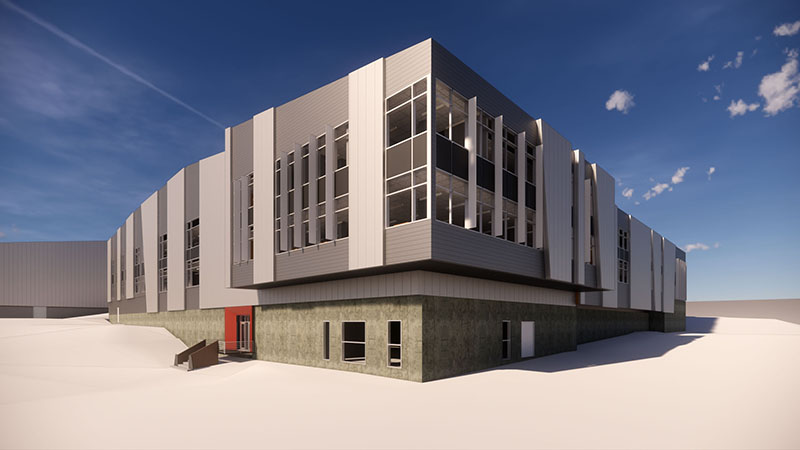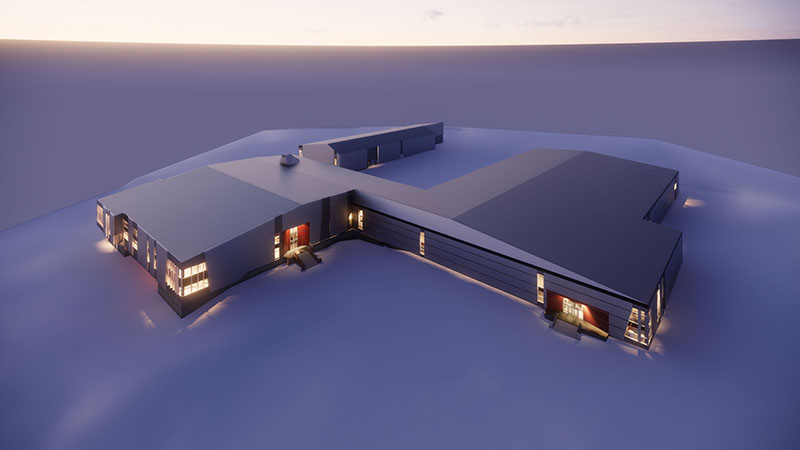A Next-Generation Antarctic Science StationNational Science Board Authorizes NSF to Begin Revitalization of McMurdo StationPosted March 7, 2019
It's official, McMurdo Station will be getting a much-needed revitalization. 
Photo Credit: Mike Lucibella
McMurdo Station as it looks now. Building-155, the big blue structure at the center, and several of the surrounding smaller buildings are slated for demolition as the new core facility is built in their place.
The National Science Board, the National Science Foundation's (NSF) governing body, in February authorized NSF to begin a comprehensive rebuilding of the largest of the three permanent United States' research stations in Antarctica. The Antarctic Infrastructure Modernization for Science project, or AIMS, will be one of the first major infrastructure modernization projects at McMurdo Station since its establishment in 1956. Over the next ten years, several buildings — some dating to the late 1950s and early 1960s — will be demolished, and their functions consolidated into new state-of-the-art energy and operationally efficient facilities. The overarching AIMS goal is to consolidate science-support operations currently dispersed in separate buildings across the existing station, thereby increasing overall logistical and energy efficiency and reducing costs. Altogether, the project will result in fewer buildings, with roughly 370,000 square feet of new construction and will remove a number of aging and inefficient buildings. These upgrades will support the nation’s cutting-edge science program in Antarctica and help ensure the United States maintains its position as a global leader in polar research. "A world-class science program is the primary expression of the nation's geopolitical presence in Antarctica and helps to ensure the U.S. keeps a leading role in Antarctic Treaty System deliberations," Kelly Falkner, director of NSF's Office of Polar Programs said in a statement announcing the project. "Through AIMS, this historic site for scientific research will gain the capabilities that will allow it to continue in its role as a leading hub for scientific endeavors." These upgrades stem from recommendations from two independent reviews of different aspects of the U.S. Antarctic Program: "More and Better Science in Antarctica through Increased Logistical Effectiveness," commissioned by the White House Office of Science and Technology Policy and NSF in 2011, and "Future Science Opportunities in Antarctica and the Southern Ocean," commissioned by the National Academy of Sciences in 2011. The two reports both highlighted the aging infrastructure at McMurdo Station, and the OSTP report in particular recommended a significant upgrade to the facilities. A Step-by-Step Construction PlanThe first two buildings slated for construction are the Vehicle Equipment Operations Center (VEOC), which will serve as the main maintenance and repair facility for McMurdo's varied fleet of vehicles, and a new 285-bed lodging facility. The VEOC will be located uphill from the rest of the station, where cargo is currently stored, while the new lodging facility will be built on a site, overlooking Winter Quarters Bay, one of the launching points for some of the earliest Antarctic expeditions. Next on the docket is construction of the largest component of the project, the Core Facility. Once completed, it will co-locate multiple operations in a single facility. The core itself will be more than 261,000 square feet of space and is scheduled to be built in stages over several years. The first stage of the Core Facility will be the Central Services and Warehouse section, which will ultimately house station management and administration, field communications, food service and dining, and food warehousing. Once that is completed, construction will begin on the Emergency Operations Center, which will house the fire department, medical facilities and recreational space. 
Photo Credit: NSF
The new 261,000 square foot core facility will be the biggest update to McMurdo Station in its 60-year history.
Following that, the Field Science Support and Industrial Trades section will be built. This facility will consolidate the station’s carpentry shop, metal work, the electrical shop, and other specialties that provide key support to science keep the station running. Adjacent to it, the Field-Science Support Center will become a "one-stop shop" for researchers gearing up before heading into the field. Cargo consolidation, field-gear storage issue, field communications, and other field equipment are key elements of this building, which will be located across the road from the existing Crary Science and Engineering Center, bringing researchers and science support personnel as close together as possible. Once AIMs is completed, McMurdo Station will look very different than it does today. The footprint of the new, more efficient station means also that a number of existing buildings will have to be torn down, including the small aerobic gym, the coffee house, the chapel, the current medical center and firehouse, since all of these functions will be incorporated into the Core facility. Ultimately, Building-155, a big blue building in the center of the station that currently houses many station services, will also be razed. It will operate until the new Central Services building is fully up and running, and construction on the Field Science Support and Industrial Trade section is about to begin. AIMS is a big undertaking, and all this construction is designed and scheduled so as not to disrupt the scientific research conducted on the station. Leidos, the primary logistical contractor to the US Antarctic Program, is partnering with Parsons to supervise the construction of the new facilities. Parsons, a technology and infrastructure contractor based in Pasadena, California, has overseen the construction of many similar large science and infrastructure projects around the world, including upgrades to NASA's Goddard Space Flight Center in Greenbelt, Maryland. "This work is incredibly important for the National Science Foundation, the ASC Program and Leidos and demonstrates our significant contribution to NSF's quest for scientific discovery in Antarctic," said Leidos Program Manager Jerry McDonald. "Building something as big and complex as AIMS is a challenge in a remote and harsh region like Antarctica, but we've got a great team and we're really looking forward to building a state-of-the-art research station." The NSB approval comes following a Final Design Review held in in October by a panel of eight experts at Leidos’s Denver offices. Currently, the team is preparing to procure equipment and construction supplies. The first building materials are scheduled to arrive on the annual supply vessel in January of 2021, with construction beginning the following October. |
"News about the USAP, the Ice, and the People"



For USAP Participants |
For The Public |
For Researchers and EducatorsContact UsU.S. National Science FoundationOffice of Polar Programs Geosciences Directorate 2415 Eisenhower Avenue, Suite W7100 Alexandria, VA 22314 Sign up for the NSF Office of Polar Programs newsletter and events. Feedback Form |


